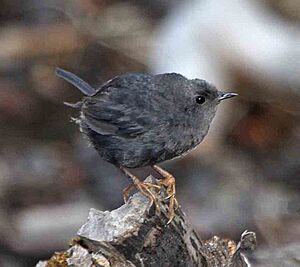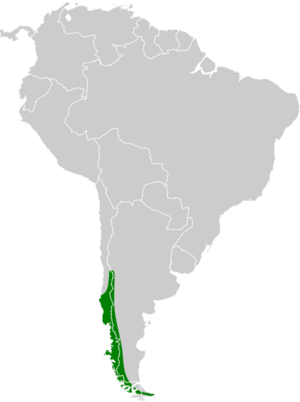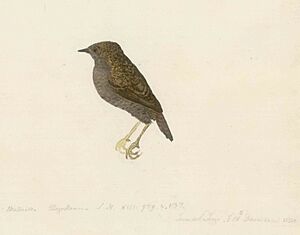Magellanic tapaculo facts for kids
Quick facts for kids Magellanic tapaculo |
|
|---|---|
 |
|
| at Cerro Chapelco, San Martín de los Andes, Neuquén Province, Argentina | |
| Conservation status | |
| Scientific classification | |
| Genus: |
Scytalopus
|
| Species: |
magellanicus
|
 |
|
The Magellanic tapaculo (its scientific name is Scytalopus magellanicus) is a small bird. It belongs to a family of birds called tapaculos. You can find this bird in the southern parts of South America.
Contents
What is a Magellanic Tapaculo?

The Magellanic tapaculo was officially named in 1789. A German scientist named Johann Friedrich Gmelin described it. He put it in the same group as wagtails at first. Its scientific name became Motacilla magellanica.
Gmelin used a description from another scientist, John Latham. Latham had called it the "Magellanic warbler." A drawing by Georg Forster helped Latham. Forster was with James Cook on his second trip around the world. He drew the bird in Tierra del Fuego in 1774. This drawing is now kept in the Natural History Museum in London. It is known as the holotype, which means it's the main example used to define the species.
This bird is considered monotypic. This means it does not have any different types or subspecies. In the past, other similar birds were thought to be subspecies of the Magellanic tapaculo. These birds lived along the Andes mountains. But now, scientists see them as their own separate species.
What Does It Look Like?
The Magellanic tapaculo is a small bird. It looks a bit like a wren. It is about 10 to 12 centimeters (4 to 5 inches) long. Its bill is thin and black. Its legs are pinkish and quite long. The bird's tail is short and often held straight up.
Its feathers are dark grey. The sides of its body, under its tail, and its wings have a reddish-brown color. Some of these birds have a shiny white patch on their head. Young birds are brown with dark stripes. They usually do not have the white patch on their head. The bird's song is loud and sounds like quick, repeated notes.
Where Does It Live?
This bird lives in South America. Its home stretches north from Tierra del Fuego. It goes as far as the Valparaíso Region in Chile. In Argentina, it reaches San Juan Province.
A famous scientist, Charles Darwin, found one of these birds in the Falkland Islands in the 1830s. However, no one has seen a Magellanic tapaculo there since then.
The bird likes to live in thick plants close to the ground. You can find it in forests and woodlands. It searches for insects to eat there. It often lives near water. It is also commonly found where there are stands of Chusquea bamboo plants.
How Does It Behave?
The Magellanic tapaculo spends most of its time on the ground. It prefers to run around instead of flying.
How Does It Reproduce?
The bird builds a round nest. It is made from moss, lichens, and plant roots. The female bird lays two or three white eggs in the nest.


